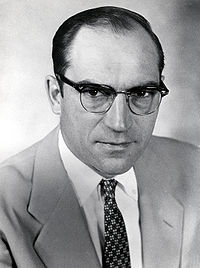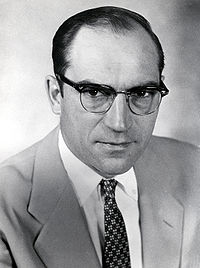Dr. Leopold, an outdoorsman all his life and former chief hydrologist of the U.S. Geological Survey, revolutionized the study of geomorphology by introducing quantitative methods into a discipline that had been purely descriptive. But he did not reduce nature to mere numbers -- his love for the natural world ranged from the study of local butterfly and sparrow populations to an intense attention to government decisions on mining, timber and water quality.
At 85, he led a scientific review panel on the restoration of the San Francisco Bay wetlands and was working until the time of his death, a colleague said.
"I talked to him a week before he died," said William Emmett, a retired hydrologist who worked with Dr. Leopold for 45 years. "His body was worn out, but his mind was twice as sharp as ever."
He published about 200 books and articles, several of which are still used in the field. Much honored for his accomplishments, he received the National Medal of Science in 1991, was a member of the National Academy of Sciences and will be posthumously awarded the prestigious Benjamin Franklin Medal in Earth and Environmental Science next month.
Dr. Leopold, who was born in Albuquerque, was the son of Aldo Leopold, one of the leading names in American conservation, and Estella Bergere, who was part of a prominent and colorful New Mexican family, the Lunas. Throughout his life, Dr. Leopold maintained an interest in the Southwest, Navajo silver and Spanish guitar. His four siblings were equally accomplished; a sister, Estella Leopold of Seattle, is also a member of the National Academy of Sciences, and a brother, A. Starker Leopold, who died in 1983, had been as well.
Dr. Leopold graduated from the University of Wisconsin in 1936 with a degree in civil engineering and joined the former U.S. Soil Conservation Service, working in the emerging field of hydrology. During World War II, he served in the Army Corps of Engineers weather service and received a master's degree from UCLA in 1944 in physics and meteorology.
After the war, he became chief meteorologist at the Pineapple Research Institute of Hawaii. In 1948, when his father died just after finding a publisher for what would be "A Sand County Almanac," Dr. Leopold edited the book and shepherded it into print the next year. In the 1960s, when it came out in paperback, it became a bestseller and a classic work of land ethics.
He received a doctoral degree in geology from Harvard University in 1950 and then combined his interests in hydrology, geology and engineering into a position with USGS in Washington.
"You could be educated in so many different disciplines in those days, and the confluence of all those fields is what really interested my father," said Madelyn Leopold of Madison, Wis. "He really had this tremendous drive toward learning and thinking."
While in Washington from 1950 until 1972, Dr. Leopold often took his family for picnics along the Watts Branch tributary of the Anacostia River and afterward, "he'd check the stream gauges he had set up there," his daughter said.
After retiring from the government, he began teaching in the Department of Geology and Geophysics at the University of California at Berkeley, where he worked until 1987, when he took an emeritus professor position.
Well known for his scientific fieldwork, he also made bows and arrows, hunted and fished, rode horses, composed piano and guitar music, danced, flew planes, painted landscapes, wrote poetry, bound books, acted on stage, built furniture, claimed to cook strawberry shortcake in a camp Dutch oven and told campfire stories. He floated on a raft through the Grand Canyon to measure the depth of the Colorado River.
"He had fun," said his friend Emmett.
He was a scientist and a conservationist and served on the boards of the Sierra Club and the Environmental Law Institute. He was a persistent critic of timber clear-cuts, cattle grazing in wilderness areas and mining in the national parks. He had a home near Pinedale, Wyo., where he banded birds for 30 years and studied which butterflies came back most quickly after a thunderstorm.
His marriage to Carolyn Leopold Michaels ended in divorce. His second wife, Barbara Beck Nelson Leopold, to whom he was married for 30 years, died in 2004.
Additional survivors include a second child from his first marriage, Bruce Leopold of Baltimore; two stepchildren, T. Leverett Nelson of Chicago and Carolyn T. Nelson of Madison; two additional siblings, Nina Leopold Bradley of Baraboo, Wis., and Carl Leopold of Ithaca, N.Y.; and two grandchildren.
Dr. Leopold, an outdoorsman all his life and former chief hydrologist of the U.S. Geological Survey, revolutionized the study of geomorphology by introducing quantitative methods into a discipline that had been purely descriptive. But he did not reduce nature to mere numbers -- his love for the natural world ranged from the study of local butterfly and sparrow populations to an intense attention to government decisions on mining, timber and water quality.
At 85, he led a scientific review panel on the restoration of the San Francisco Bay wetlands and was working until the time of his death, a colleague said.
"I talked to him a week before he died," said William Emmett, a retired hydrologist who worked with Dr. Leopold for 45 years. "His body was worn out, but his mind was twice as sharp as ever."
He published about 200 books and articles, several of which are still used in the field. Much honored for his accomplishments, he received the National Medal of Science in 1991, was a member of the National Academy of Sciences and will be posthumously awarded the prestigious Benjamin Franklin Medal in Earth and Environmental Science next month.
Dr. Leopold, who was born in Albuquerque, was the son of Aldo Leopold, one of the leading names in American conservation, and Estella Bergere, who was part of a prominent and colorful New Mexican family, the Lunas. Throughout his life, Dr. Leopold maintained an interest in the Southwest, Navajo silver and Spanish guitar. His four siblings were equally accomplished; a sister, Estella Leopold of Seattle, is also a member of the National Academy of Sciences, and a brother, A. Starker Leopold, who died in 1983, had been as well.
Dr. Leopold graduated from the University of Wisconsin in 1936 with a degree in civil engineering and joined the former U.S. Soil Conservation Service, working in the emerging field of hydrology. During World War II, he served in the Army Corps of Engineers weather service and received a master's degree from UCLA in 1944 in physics and meteorology.
After the war, he became chief meteorologist at the Pineapple Research Institute of Hawaii. In 1948, when his father died just after finding a publisher for what would be "A Sand County Almanac," Dr. Leopold edited the book and shepherded it into print the next year. In the 1960s, when it came out in paperback, it became a bestseller and a classic work of land ethics.
He received a doctoral degree in geology from Harvard University in 1950 and then combined his interests in hydrology, geology and engineering into a position with USGS in Washington.
"You could be educated in so many different disciplines in those days, and the confluence of all those fields is what really interested my father," said Madelyn Leopold of Madison, Wis. "He really had this tremendous drive toward learning and thinking."
While in Washington from 1950 until 1972, Dr. Leopold often took his family for picnics along the Watts Branch tributary of the Anacostia River and afterward, "he'd check the stream gauges he had set up there," his daughter said.
After retiring from the government, he began teaching in the Department of Geology and Geophysics at the University of California at Berkeley, where he worked until 1987, when he took an emeritus professor position.
Well known for his scientific fieldwork, he also made bows and arrows, hunted and fished, rode horses, composed piano and guitar music, danced, flew planes, painted landscapes, wrote poetry, bound books, acted on stage, built furniture, claimed to cook strawberry shortcake in a camp Dutch oven and told campfire stories. He floated on a raft through the Grand Canyon to measure the depth of the Colorado River.
"He had fun," said his friend Emmett.
He was a scientist and a conservationist and served on the boards of the Sierra Club and the Environmental Law Institute. He was a persistent critic of timber clear-cuts, cattle grazing in wilderness areas and mining in the national parks. He had a home near Pinedale, Wyo., where he banded birds for 30 years and studied which butterflies came back most quickly after a thunderstorm.
His marriage to Carolyn Leopold Michaels ended in divorce. His second wife, Barbara Beck Nelson Leopold, to whom he was married for 30 years, died in 2004.
Additional survivors include a second child from his first marriage, Bruce Leopold of Baltimore; two stepchildren, T. Leverett Nelson of Chicago and Carolyn T. Nelson of Madison; two additional siblings, Nina Leopold Bradley of Baraboo, Wis., and Carl Leopold of Ithaca, N.Y.; and two grandchildren.
Family Members
Sponsored by Ancestry
Advertisement
Advertisement








